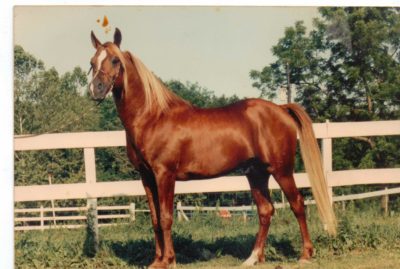Dakhala Bashiq, 1984 asil Ma’naqi Sbaili stallion
Also from Facebook — and I gave up on trying to compete with it here, lol — comes this gorgeous photo which Edna Ehret posted of the asil 1984 Ma’naqi Sbaili stallion Dakhala Bashiq (Plantagenet x Soiree by Sir), the full brother of my 1985 Dakhala Sahra, both bred by Jeanne Craver. Two failed embryo transfer attempts on Sahra so far, third is the charm, please wish me luck. Mrs. Ehret sold him to a person whose name she does not remember.


best of luck with the ET. fingers are crossed.
That horse is built like a brick you know what. Tons of hanad up within 3 or so generations- dextremely typey head- grat width across the eyes indicating intelligence, very good leg bone. I’m wondering if there’s any female breeding of this left?
best wishes
Bruce Peek
He has a full sister that I own and that I am desperately trying to do ET with. She is 28. One of the best mares I have ever seen. A heck of a mare, built to carry a Bedouin warrior on a 300 mile raid and back.
open minded investigation and comparison of the Muniqi strain leads to the conclusion that Raswan was wrong about them being weedy- weak coupled scarecrows. Consider the historial record, the Darley arabian, Obayan built like a tank and imported to Babolna by General Haddad, Haleb with his large leg bone, short back and dishy head, Bango the North african Muniqi imported to France, Zamal of the hearst importation, all of them visibly three circle horses. I think an easy explanation of Raswans claim that Muniqi crosses with Saqlawi gave weak couplings might be attributed to the increased height such a cross gave. The taller horses would obviously need more groceries to bulk up. One of the first places a horse shows as an indicator of being underweight is a dropoff in condition of the back. Photos of the horses mentioned show that none of them had weak peaky croups, instead they showed smooth powerful couplings with exemplary hip angles. In this aspect of conformation Dakhala Bashiq goes right along with rest. He even shows a slight tendency to stand under and point out with the hind legs an adaptation of close coupled horses so they can clear their barrel and swing wide
with the hind leg as track up. This is a distinct advantage in spins, pirouettes, piaffe and passage.
I wonder who else is breeding tale female Muniqi horses..
best wishes
Bruce Peek
if only everyone thought like you think and saw what you saw.. i can write chapters about the asalah of Ma’naqis.
The overemphasis on the show breed standard of ,’ comparitively level hindquarters,’ has I suspect given us horses that don’t move well. Look at the pictures of Lorien HD and Trilogy, both are tucking their hips under them as they trot- very pure gaits two beat diagonal with a moment of suspension. Even in the most extreme extended trot possible trilogys trot is still pure because his pelvis is still underneath him.
The tendency of the Muniqis to have a downward sloping hip angle as per Raswans description should be viewed as a positive confirmational feature, not as a drawback. To be clear, the two breeding groups having the most to give to save and rejuvenate the modern flat moving show arabs appear to be the Muniqis, and the Davenports.
Best wishes
Bruce Peek
P.S. Hope your aged Muniqi mare has a good strong colt that can be used to upgrade the breeding of many waho arabs and help save the breed.
A second to Bruce’s P. S.!
To follow up, Edouard, as I recall you had an entry on this blog sometime back about one of the last documented Ghazus in the early 1940s, by the Rualla against I think the Fadaan bedouins. IIRC the Rualla were mostly mounted on horses, not all mares, that descended from a certain Muniqi stallion. Would that entry be in the strain information series about Muniqis?
Best wishes
Bruce Peek
yes you can find it here:
http://daughterofthewind.org/of-three-more-managhi-sbayli-stallions-bashiq-haleb-and-funaytil/